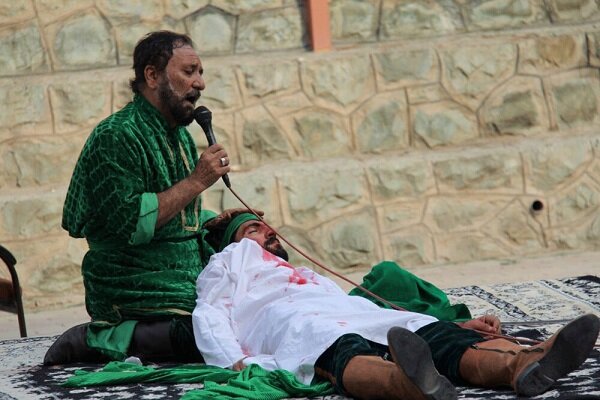After the advent of Islam in Iran and the consolidation by the Safavid dynasty (1502-1736) of Shia Islam as the state religion of Iran, the Shia have always tried to keep the tragedy of Ashura alive.
Ashura is the 10th day of Muharram, the day upon which Imam Hussein (AS) and his companions were martyred in Karbala, Iraq in 680 CE.
One of the efforts made to keep this tragedy alive is the religious performances in form of tazieh, Iranian passion play, which are mainly organized during the first 10 days of the lunar calendar month of Muharram.
However, expert on tazieh Ala’eddin Qasemi believes that tazieh can be performed throughout the year every day.
“At the present time, I have 400 tazieh plays ready to be performed and I can stage them on 400 nights throughout the year,” Qasemi told the Tehran Times in a recent interview.
“We have taizeh plays on all the Imams of the Shia. We also have comic tazieh plays like ‘The Meeting of Prophet Solomon and the Queen of Sheba’ which is a very delightful and comic tazieh,” he explained.
“The root of the word tazieh comes from the Arabic-Persian word ‘aza’ which means mourning and grieving. So some may imagine that tazieh only depicts events that are related to mourning and sorrow. But happy and joyful events in the history of Islam and Iran can also be the theme of tazieh,” Qasemi said.
“The kind of tazieh depends on the occasion, but when the two months of Muharram and Safar, (the first and second months of the lunar calendar) are over, the tazieh performances are over too,” he regretted.
Over all these years, tazieh has been performed across the country in all the cities and villages reminding the viewers of the tragedy of Ashura, and these performances have always been warmly welcomed by people from all walks of life.
Tazieh performances are so impressive that at times members of the audience feel themselves to be in the main core of the event being depicted by it.
Many experts believe that tazieh is the unique passion play of the Islamic world and also one of the most traditional types of theater in the world.
Qasemi and his friends have participated in various Iranian and international traditional and religious theater festivals.
“We gave our first international performance during an Italian festival on Imam Reza (AS),” he said.
Afterwards, the legendary filmmaker Abbas Kiarostami invited them to perform in Rome for one month.
“Later we were invited to perform in New York and the performance was warmly received mostly by local people,” he said.
Qasemi said that tazieh performances are highly regarded overseas for at least two reasons. First for their musical form and more importantly, because of the specific costumes the thespians don during the performances.
A tazieh performance is composed of music, poetry, and its specials techniques. In addition, the audience’s knowledge of history and their faith are the keys to better understand it.
“Music and the voices of the performers play major roles. All of the dialogues have a poetic form and are sung with music. Therefore, if the performer does not have a good voice, he will not be well received,” Qasemi said.
Qasemi said that taizeh as a dramatic art is respected in the country. However, he lamented the lack of a permanent location for such performances.
Dowlat Tekyeh, a place for seasonal Islamic ceremonies that was built during the reign of Qajar king Nasser ad-Din Shah near the Golestan Palace in downtown Tehran was a permanent place for tazieh performances. Troupes used to stage their performances at the tekyeh, which was a three-story building 24 meters in height with a circular shape covering 2,824 square meters in area. Unfortunately, the structure was demolished years ago.
“We need a permanent center to perform every night. It should not just be limited to Muharram and seasonal performances,” Qasemi said.
He added that his efforts to convince cultural officials to allocate a permanent special place for tazieh performances have been in vain.
The Society for Iranian Tazieh was established several years ago aiming to train young talents to perform tazieh. It also attempts to focus on restoring old tazieh scripts, as well as producing costumes and instruments used during the tazieh performances.
“But the accessories, the costumes and the properties are preserved by some individuals who rent them whenever needed,” he said, adding that the society has not been able to establish a sufficiently large tekyeh for tazieh in Tehran.
“We wish that the society could help establish troupes and get sponsors to organize taziehs, however, none of these have happened so far,” he lamented.
Tazieh was registered on UNESCO’s List of the Intangible Cultural Heritage of Humanity in November 2010.
This year, Qasemi has been invited to perform tazieh in Sirjan, Kerman Province, during Muharram.
He also said television has had a great role in introducing the intangible cultural heritage.
“The TV series ‘The Tenth Night’ directed by Hassan Fat’hi, introduced tazieh to the audience in the best way possible. These types of programs can help promote tazieh more,” he concluded.
MNA/TT
